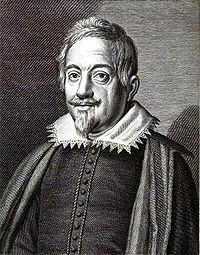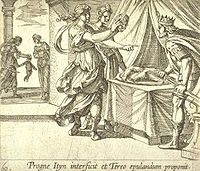
Antonio Tempesta
Encyclopedia


Italy
Italy , officially the Italian Republic languages]] under the European Charter for Regional or Minority Languages. In each of these, Italy's official name is as follows:;;;;;;;;), is a unitary parliamentary republic in South-Central Europe. To the north it borders France, Switzerland, Austria and...
painter and engraver, a point of connection between Baroque Rome and the culture of Antwerp. He was born and trained in Florence
Florence
Florence is the capital city of the Italian region of Tuscany and of the province of Florence. It is the most populous city in Tuscany, with approximately 370,000 inhabitants, expanding to over 1.5 million in the metropolitan area....
and painted in a variety of styles, influenced to some degree by "Contra-Maniera" or Counter-Mannerism
Counter-Mannerism
Counter-Mannerism is a general art historical term for a trend in painting, printmaking and interior decoration that originated as a sub-category of Mannerism. Contra-Maniera followed the general worldliness of the second generation of Mannerist painters...
. He enrolled in the Florentine Accademia delle Arti del Disegno
Accademia delle Arti del Disegno
The Accademia delle Arti del Disegno of Florence promotes the safeguard of the works of art in Italy. Founded in 1563, it was the first academy of drawing established in Europe.- History of the Accademia :...
in 1576, and was a pupil of Santi di Tito
Santi di Tito
Santi di Tito was an Italian painter of Late-Mannerist or proto-Baroque style, what is sometimes referred to as Contra-Maniera or Counter-Mannerism.-Biography:...
, then of the Flemish painter Joannes Stradanus. He is now best known as a printmaker in etching
Etching
Etching is the process of using strong acid or mordant to cut into the unprotected parts of a metal surface to create a design in intaglio in the metal...
and engraving.
He was part of the large set of artists working under Giorgio Vasari
Giorgio Vasari
Giorgio Vasari was an Italian painter, writer, historian, and architect, who is famous today for his biographies of Italian artists, considered the ideological foundation of art-historical writing.-Biography:...
on the interior decoration of the Palazzo Vecchio
Palazzo Vecchio
The Palazzo Vecchio is the town hall of Florence, Italy. This massive, Romanesque, crenellated fortress-palace is among the most impressive town halls of Tuscany...
.
His favorite subjects were battles, cavalcades, and processions. He relocated to Rome
Rome
Rome is the capital of Italy and the country's largest and most populated city and comune, with over 2.7 million residents in . The city is located in the central-western portion of the Italian Peninsula, on the Tiber River within the Lazio region of Italy.Rome's history spans two and a half...
, where he associated with artists from the Netherlands, which may have led to his facility with landscape painting.
Commissions
He and Mattheus BrillPaul and Mattheus Brill
Paul and Matthijs Bril were brothers, both born in Antwerp, who were landscape painters who worked in Rome after earning papal favor.-Biography:...
were commissioned by Pope Gregory XIII
Pope Gregory XIII
Pope Gregory XIII , born Ugo Boncompagni, was Pope from 1572 to 1585. He is best known for commissioning and being the namesake for the Gregorian calendar, which remains the internationally-accepted civil calendar to this date.-Youth:He was born the son of Cristoforo Boncompagni and wife Angela...
to paint wide panoramas of the Procession to Transfer the Relics of St Gregory of Nazianzus (1572) for the loggia
Loggia
Loggia is the name given to an architectural feature, originally of Minoan design. They are often a gallery or corridor at ground level, sometimes higher, on the facade of a building and open to the air on one side, where it is supported by columns or pierced openings in the wall...
s on the third floor of the Vatican Palace
Apostolic Palace
The Apostolic Palace is the official residence of the Pope, which is located in Vatican City. It is also known as the Sacred Palace, the Papal Palace and the Palace of the Vatican...
. He completed frescoes in the Palazzina Gambara at the Villa Lante
Villa Lante
Villa Lante at Bagnaia is a Mannerist garden of surprise near Viterbo, central Italy, attributed to Jacopo Barozzi da Vignola).The villa is known as the "Villa Lante"...
in Bagnaia (1578-09). From 1579-1583, Tempesta participated in the decoration of the Villa Farnese
Villa Farnese
The Villa Farnese, also known as Villa Caprarola, is a mansion in the town of Caprarola in the province of Viterbo, Northern Lazio, Italy, approximately 50 kilometres north-west of Rome...
in Caprarola
Caprarola
Caprarola is a town and comune in the province of Viterbo, in the Lazio region of central Italy. The village is situated in a range of volcanic hills known as the Cimini Mounts....
, notably of this villa's Scala Regia. He is also known to have collaborated on fresco
Fresco
Fresco is any of several related mural painting types, executed on plaster on walls or ceilings. The word fresco comes from the Greek word affresca which derives from the Latin word for "fresh". Frescoes first developed in the ancient world and continued to be popular through the Renaissance...
es in the Villa d'Este
Villa d'Este
The Villa d'Este is a villa situated at Tivoli, near Rome, Italy. Listed as a UNESCO world heritage site, it is a fine example of Renaissance architecture and the Italian Renaissance garden.-History:...
at Tivoli
Tivoli, Italy
Tivoli , the classical Tibur, is an ancient Italian town in Lazio, about 30 km east-north-east of Rome, at the falls of the Aniene river where it issues from the Sabine hills...
and the Palazzina Gamara at Villa Lante
Villa Lante
Villa Lante at Bagnaia is a Mannerist garden of surprise near Viterbo, central Italy, attributed to Jacopo Barozzi da Vignola).The villa is known as the "Villa Lante"...
, Bagnaia He painted series of turbulent and crowded battle scenes for the Medici. He also completed a series of engravings on outdoor courtly hunting scenes. He illustrated many books, including editions of Ovid
Ovid
Publius Ovidius Naso , known as Ovid in the English-speaking world, was a Roman poet who is best known as the author of the three major collections of erotic poetry: Heroides, Amores, and Ars Amatoria...
. He also painted frescoes for the Palazzos Colonna
Palazzo Colonna
The Palazzo Colonna is a palatial block of buildings in central Rome, Italy, at the base of the Quirinal Hill, and adjacent to the church of Santi Apostoli...
, the Doria Pamphilj, and for the Marchese Giustiniani in his Roman palace, where Tempesta collaborated with Paul Bril
Paul and Mattheus Brill
Paul and Matthijs Bril were brothers, both born in Antwerp, who were landscape painters who worked in Rome after earning papal favor.-Biography:...
and at Bassano Sutri. He also drew many designs for tapestries. He painted a Murder of the Innocents for the church of Santo Stefano Rotondo
Santo Stefano Rotondo
The Basilica of St. Stephen in the Round on the Celian Hill is an ancient basilica and titular church in Rome, Italy. Commonly named Santo Stefano Rotondo, the church is the National church in Rome of Hungary dedicated to Saint Stephen and Saint Stephen of Hungary...
in Rome. He also left numerous etchings, among them: Plates from the Old Testament; twenty-four plates from the Life of St. Anthony; a set of 150 prints from Ovid’s Metamorphoses; 13 plates on The Labors of Hercules; four plates on The Ages of Man; The Entry of Alexander into Babylon; Diana and Actaon, and The Crucifixion (1612).
In the church of Santo Stefano Rotondo
Santo Stefano Rotondo
The Basilica of St. Stephen in the Round on the Celian Hill is an ancient basilica and titular church in Rome, Italy. Commonly named Santo Stefano Rotondo, the church is the National church in Rome of Hungary dedicated to Saint Stephen and Saint Stephen of Hungary...
, there is a Murder of the Innocents. He also left some 1800 etchings. Among his numerous prints are plates from the Old Testament; Twenty-four plates from the Life of St. Anthony; A set of one hundred and fifty prints from Ovid’s Metamorphoses; The Labors of Hercules: The Ages of Man in four plates; The Entry of Alexander into Babylon; Diana and Acteaon; and The Crucifixion (1612).
He engraved plates in "Batavorum cum Romanis Bellum" for Otto van Veen
Otto van Veen
Otto van Veen, also known by his Latinized name Otto Venius or Octavius Vaenius, was a painter, draughtsman, and humanist active primarily in Antwerp and Brussels in the late sixteenth and early seventeenth century...
, also known as Vaenius, which was produced in 1612. It consists of 36 numbered engraved plates by Antonio Tempesta after Vaenius. It is a series of allegorical engravings illustrating the armed struggle between the ancient Dutch tribes and their Roman oppressors inspired by Tacitus's history. Each plate bears an engraved legend below in Flemish and in Latin; a detailed explanation is printed on the otherwise blank verso. This historicist work, very popular in its time, was achieved by two great artists: the designer, Otto Vaenius (Otto van Veen 1556-1629), court painter to Alessandro Farnese, was influenced by the Italian mannerists but had developed his own style anticipating the Flemish baroque of his pupil Peter Paul Rubens; the engraver, Antonio Tempesta (1555-1630), specialized in battle scenes. Plate I, signed 'Ant.Tempesta f. Anno 1611', shows 'Roma' and 'Batavia' in battle dress with respective scenic backgrounds, symbolizing the two nations; 15 other plates bear Tempesta's monogramme. The plates depict heroic events, sieges, and battle scenes.

